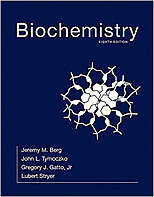
Biochemistry
Berg, Jeremy M.; Tymoczko, John L.; Gatto, Jr., Gregory J.; Stryer, Lubert
8 ed.
New York: W.H. Freeman and Company, 2015
 |
Biochemistry Berg, Jeremy M.; Tymoczko, John L.; Gatto, Jr., Gregory J.; Stryer, Lubert 8 ed. New York: W.H. Freeman and Company, 2015 |
40 termes
| D amino acid n. |
|
| D isomer n. |
|
| decorated actin n. |
|
| deficiency disorder n. |
|
| degradative pathway n. |
|
| degron n. |
|
| Deinococcus radiodurans [nom científic] |
|
| deleterious reaction n. |
|
| denatured ribonuclease n. |
|
| deoxyguanosine 3'-monophosphate n. (3'-dGMP) |
|
| deoxynucleoside 5'-triphosphate n. |
|
| deoxynucleoside triphosphate n. (dNTP) |
|
| deoxyribonucleoside 3'-phosphoramidite n. |
|
| deoxyribose phosphodiesterase n. |
|
| designer gene n. |
|
| developmental process n. |
|
| diacylglycerol kinase n. |
|
| Dictyostelium discoideum [nom científic] |
|
| dieting n. |
|
| diffusion-controlled encounter n. |
|
| diphthamide n. |
|
| disease-causing mutation n. |
|
| displacement loop n. (D-loop) |
|
| divalent metal ion n. |
|
| D-loop n. (displacement loop) |
|
| DNA polymerase |
|
| DNA recognition n. |
|
| DNA synthesis n. |
|
| DNA-binding receptor n. |
|
| DNA-binding structure n. |
|
| dNTP n. (deoxynucleoside triphosphate) |
|
| docking mode n. |
|
| domain arrangement n. |
|
| dopamine D2 receptor n. |
|
| double sieve n. |
|
| double-blinded study n. |
|
| double-stranded RNA n. |
|
| downstream core promoter element n. (DPE) |
|
| DPE n. (downstream core promoter element ) |
|
| dUMP n. (deoxyuridylate) |
|